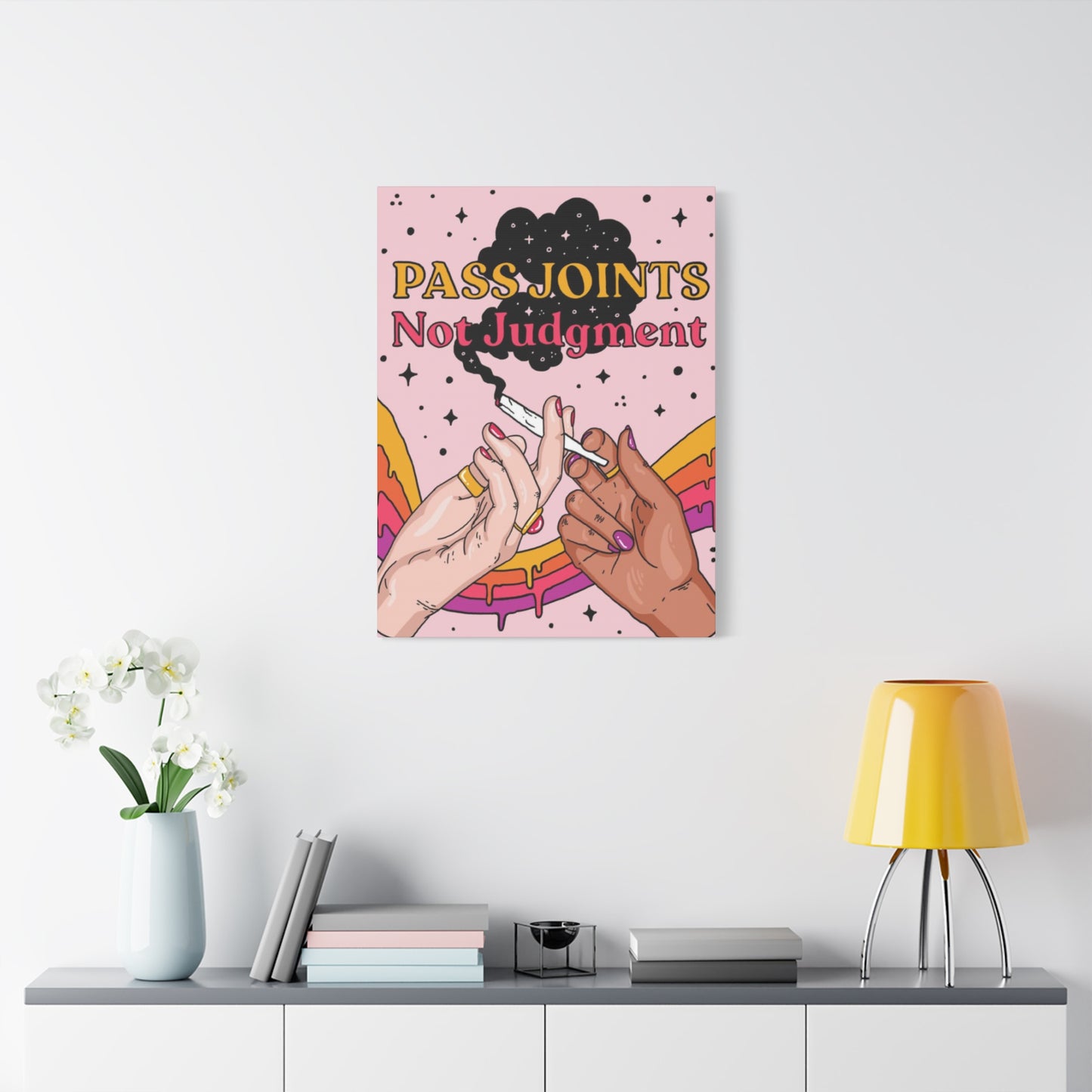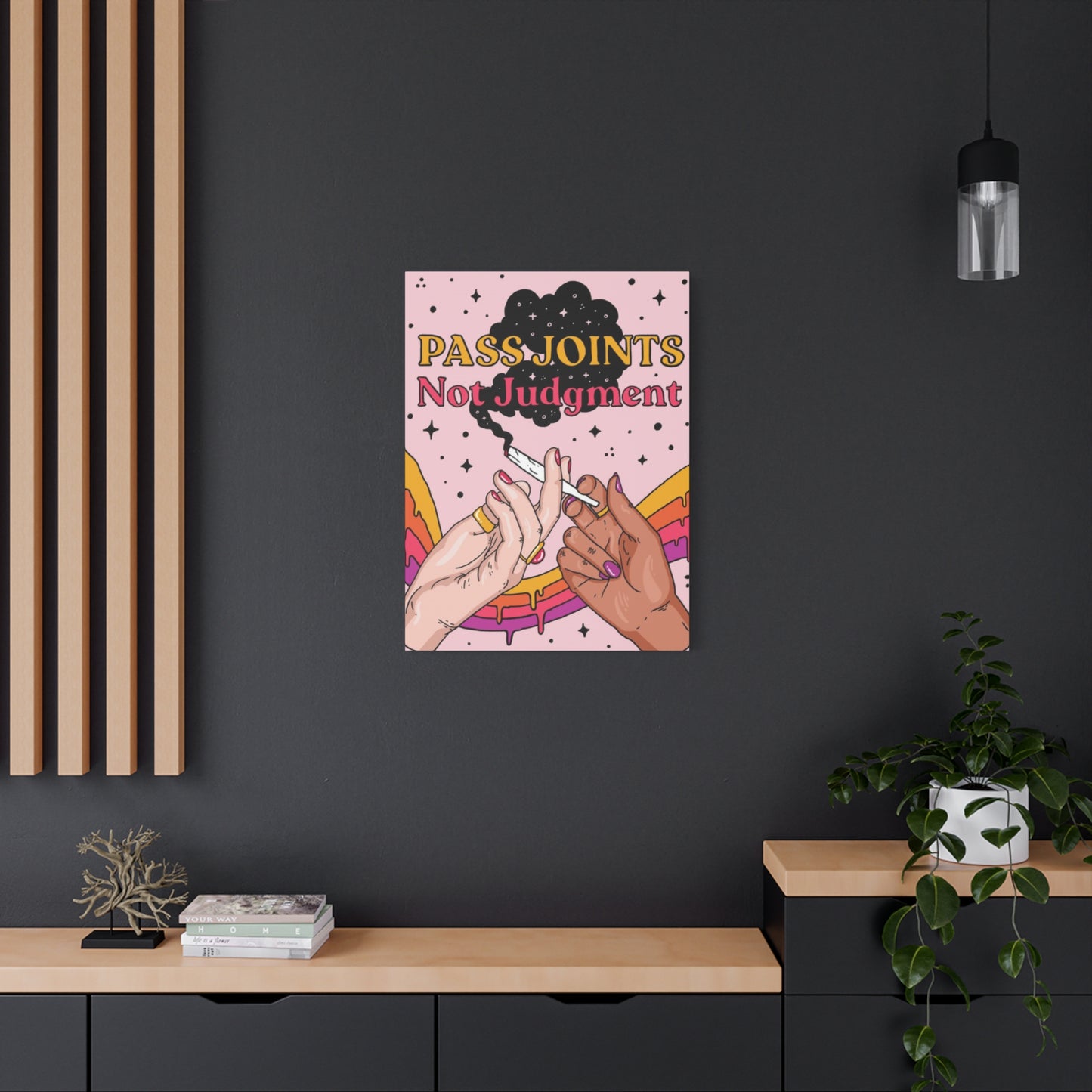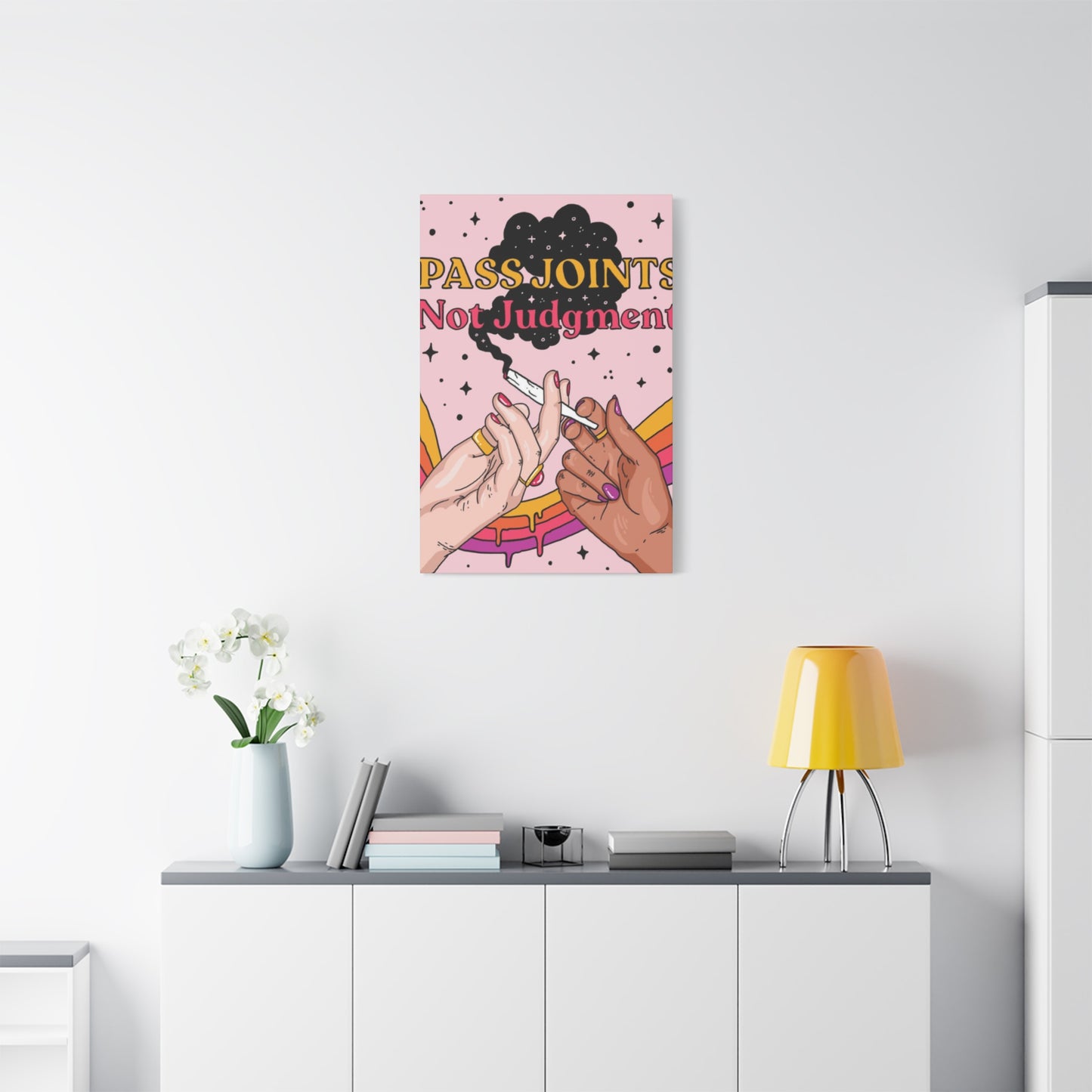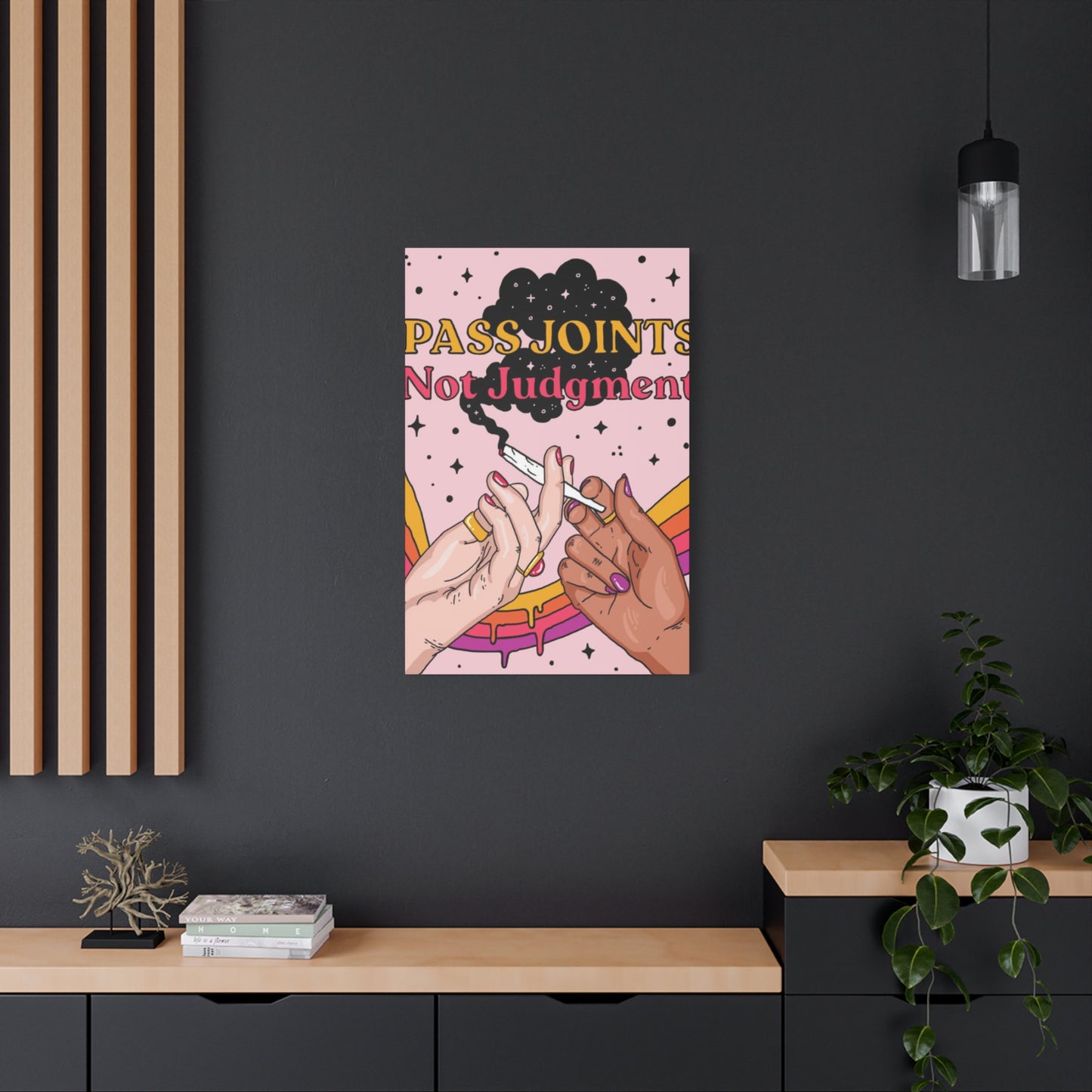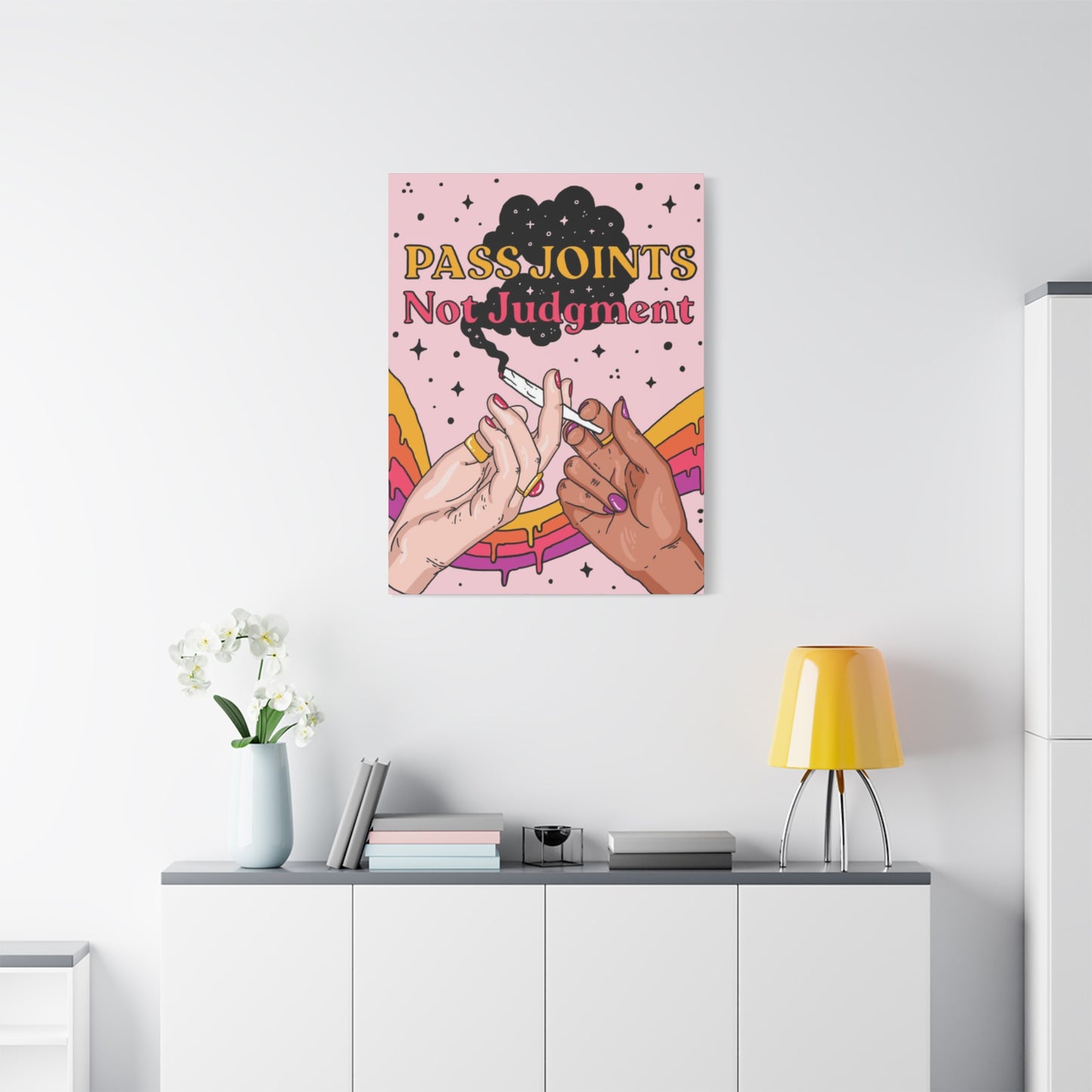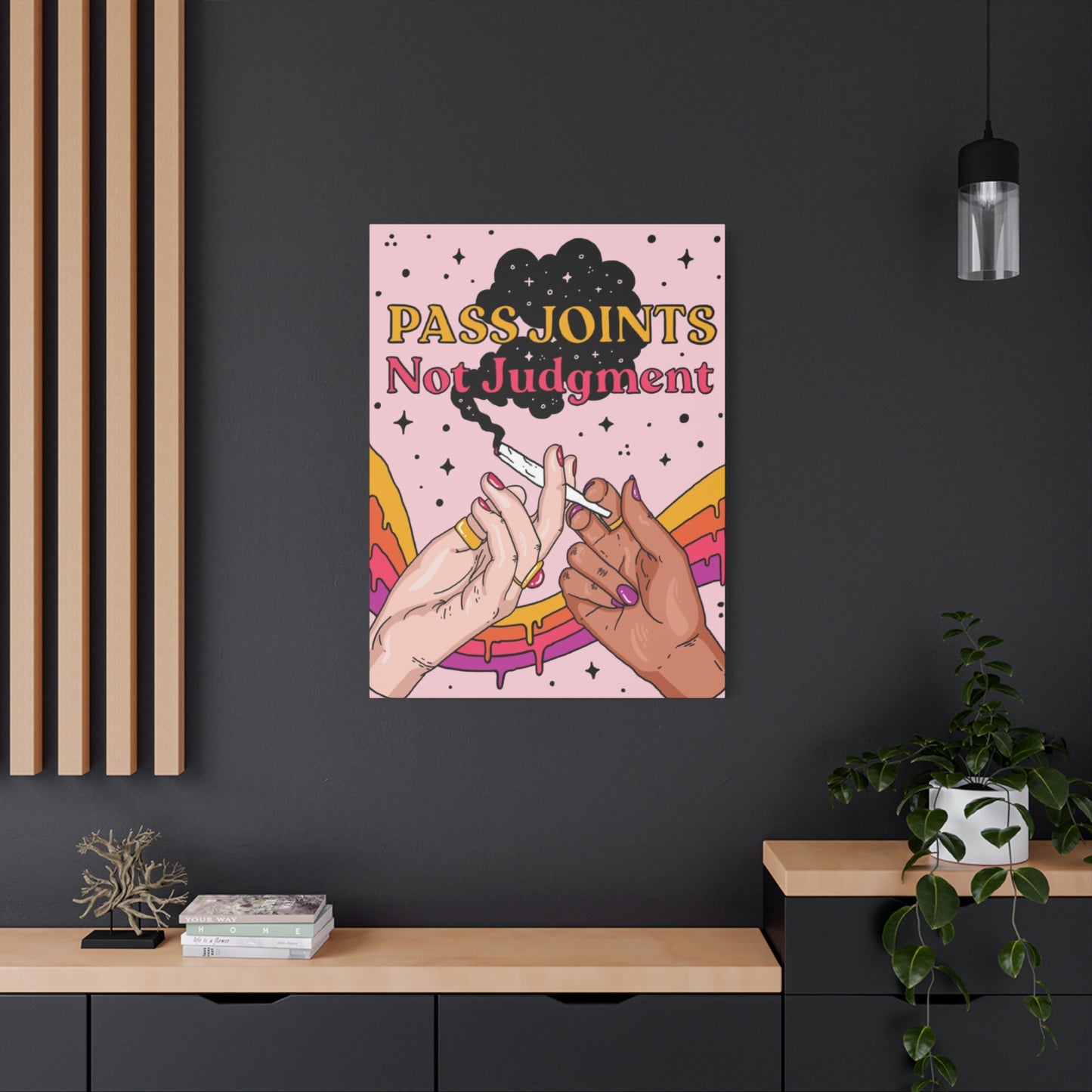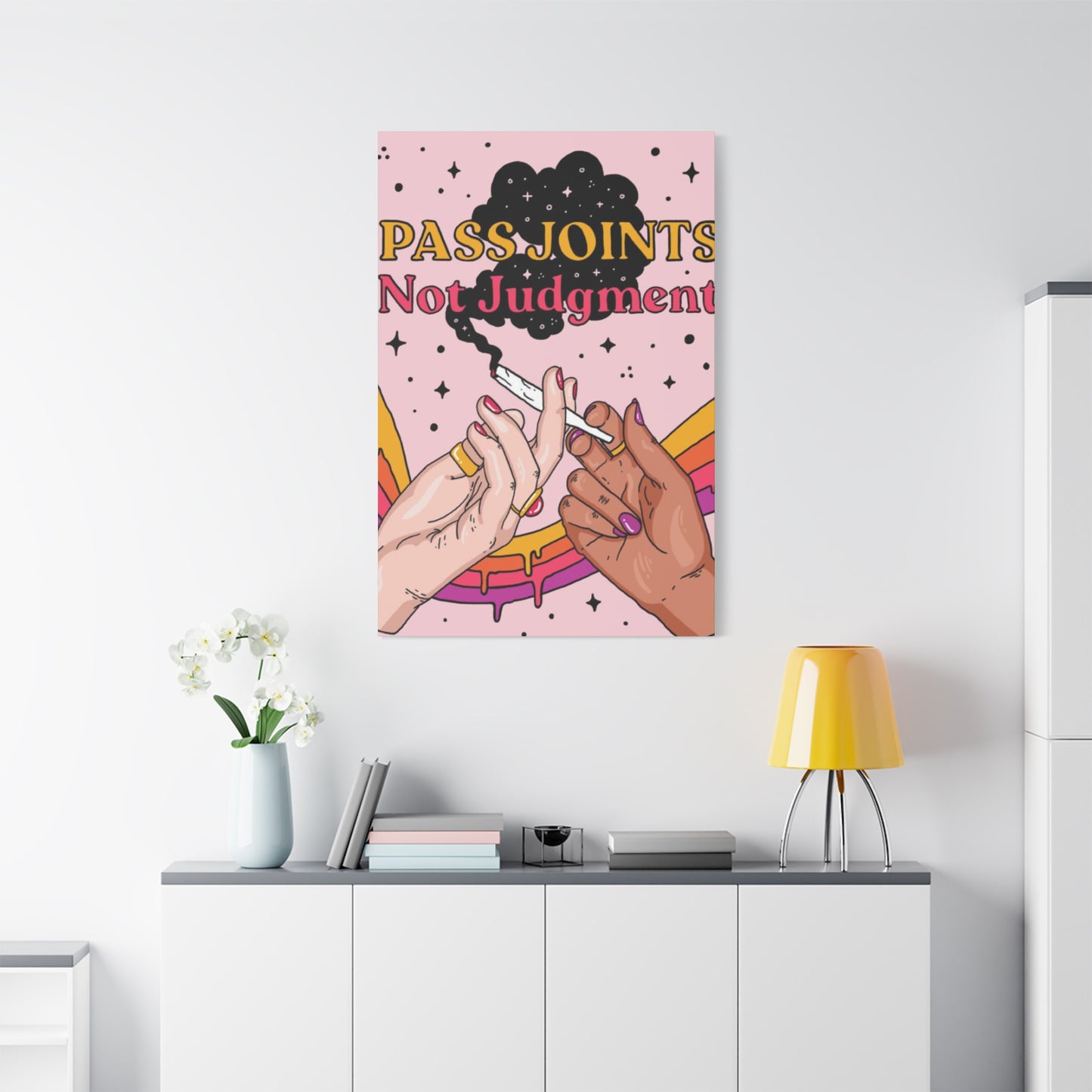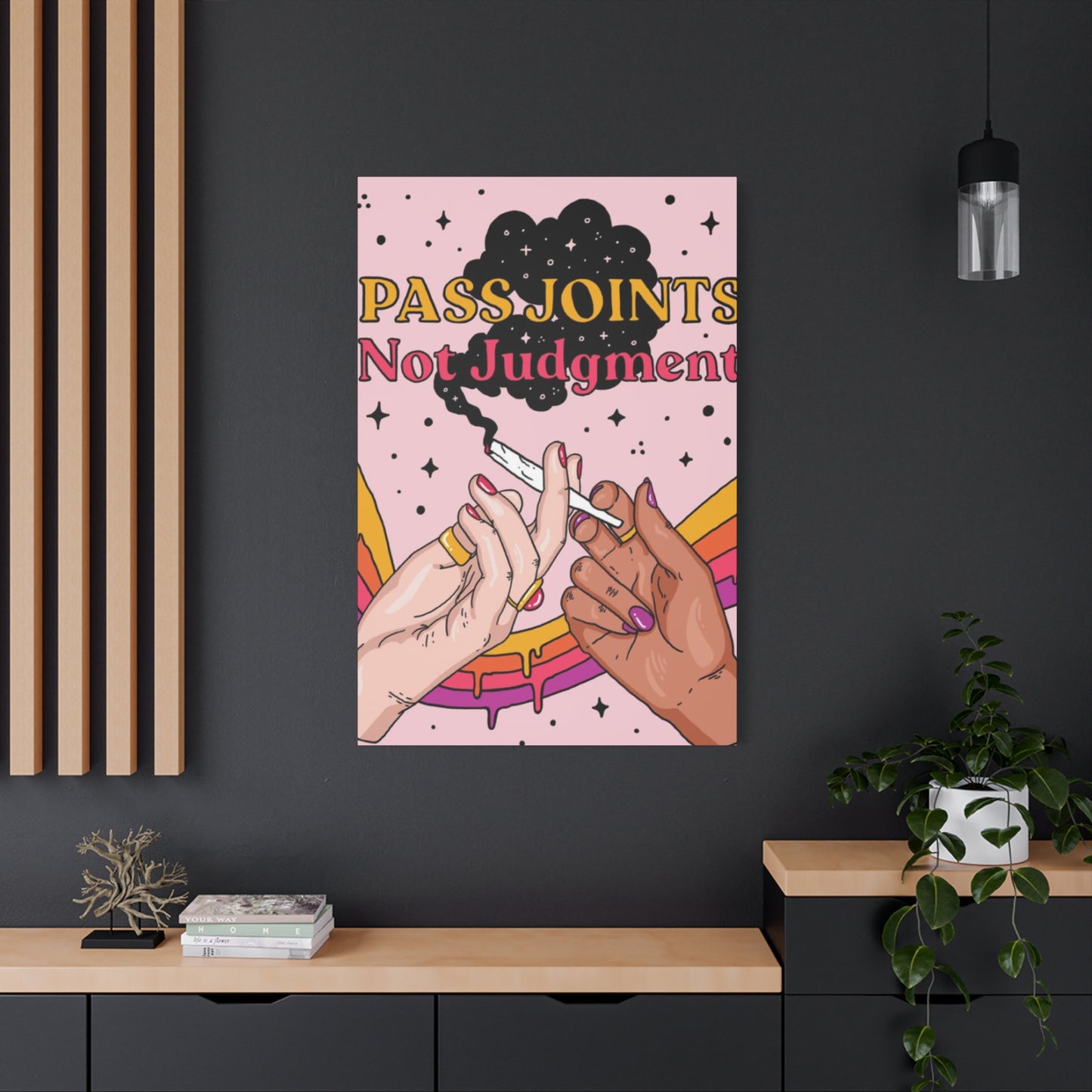Elevate Your Space: The Rise of Pass-Joints Marijuana Wall Art
Cannabis culture has evolved significantly over recent decades, moving from underground movements to mainstream acceptance. This cultural shift has brought forth a new wave of artistic expression that celebrates the plant's aesthetic beauty, cultural significance, and symbolic meaning. Artists worldwide have embraced cannabis themes, creating stunning visual representations that capture everything from the plant's intricate botanical details to abstract interpretations of its cultural impact.
The artistic representation of cannabis extends far beyond simple leaf illustrations. Contemporary artists explore themes of freedom, natural beauty, counterculture movements, and personal expression through their cannabis-inspired works. These pieces often incorporate vibrant colors, intricate patterns, and symbolic elements that resonate with enthusiasts and art lovers alike.
Modern cannabis artwork ranges from photorealistic botanical studies to psychedelic interpretations, street art influences, and minimalist designs. Each style offers unique aesthetic qualities that can complement various decorative schemes. The diversity in artistic approaches ensures that there are suitable options for different tastes, preferences, and living environments.
The growing acceptance of cannabis in many regions has also contributed to the mainstream appreciation of cannabis-themed artwork. What was once considered taboo or underground has now found its place in galleries, homes, and commercial establishments. This shift has encouraged more artists to explore cannabis themes openly, resulting in a rich variety of creative expressions.
Cannabis-themed artwork often incorporates elements of nature, spirituality, and cultural symbolism. Many pieces draw inspiration from the plant's natural growing environment, featuring lush green landscapes, sunset scenes, and botanical gardens. Others focus on the cultural aspects, incorporating elements from different cannabis traditions around the world.
The therapeutic and medicinal properties of cannabis have also inspired artistic interpretations. Some artists create works that explore themes of healing, wellness, and natural medicine. These pieces often feature calming color palettes and serene compositions that evoke feelings of peace and tranquility.
Benefits of Canvas Print Technology for Artistic Displays
Canvas printing technology has revolutionized how we display and enjoy artwork in residential and commercial settings. This printing method offers numerous advantages over traditional paper prints, making it an ideal choice for cannabis-themed artwork and other decorative pieces. The durability and longevity of canvas prints make them particularly suitable for long-term display purposes.
Canvas material provides a unique texture that closely mimics traditional painted artwork. This texture adds depth and dimension to printed images, creating a more authentic artistic experience. The fabric surface interacts with light in ways that enhance color vibrancy and create subtle shadows that add visual interest to the displayed piece.
The printing process used for canvas artwork involves high-quality inks that penetrate deep into the fabric fibers. This penetration ensures that colors remain vibrant and fade-resistant for extended periods. Professional-grade canvas prints can maintain their visual appeal for decades when properly cared for and displayed away from direct sunlight.
Canvas prints offer excellent versatility in terms of sizing options. From small accent pieces to large statement artworks, canvas technology can accommodate various dimensions without compromising image quality. This flexibility allows for creative display arrangements and makes it possible to find suitable pieces for any available wall area.
The lightweight nature of canvas prints makes them easy to hang and reposition as needed. Unlike heavy framed paintings or glass-covered prints, canvas artwork can be mounted with simple hardware and moved without significant effort. This convenience is particularly valuable for renters or those who enjoy frequently updating their decorative arrangements.
Canvas prints also offer superior resistance to environmental factors such as humidity and temperature fluctuations. The fabric material expands and contracts naturally with environmental changes, reducing the risk of cracking or warping that can affect other printing substrates. This resilience makes canvas prints suitable for various room types, including bathrooms and kitchens.
Choosing Appropriate Sizes for Different Room Configurations
Selecting the right size for cannabis-themed canvas prints requires careful consideration of room dimensions, furniture placement, and overall decorative goals. The relationship between artwork size and available wall area plays a crucial role in creating visually balanced and appealing displays. Understanding basic proportion principles helps ensure that chosen pieces enhance rather than overwhelm their surroundings.
Small canvas prints, typically measuring 8x10 to 16x20 inches, work well as accent pieces in intimate settings. These sizes are perfect for bedrooms, bathrooms, home offices, and other areas where subtle decorative touches are preferred. Small prints can also be grouped together to create gallery walls or themed collections that tell a visual story.
Medium-sized canvas prints, ranging from 18x24 to 24x36 inches, offer more visual impact while remaining versatile enough for most room configurations. These dimensions work particularly well above furniture pieces such as sofas, beds, or dining room sideboards. Medium prints can serve as focal points without dominating the entire room's visual landscape.
Large canvas prints, measuring 30x40 inches and beyond, create dramatic statements that can transform entire room atmospheres. These substantial pieces work best in rooms with high ceilings and ample wall area. Large cannabis-themed prints can serve as conversation starters and primary decorative elements in living rooms, dining areas, or entertainment rooms.
When selecting sizes for multiple pieces, consider creating visual harmony through consistent proportions or deliberate variation. Three pieces of similar sizes can create a cohesive triptych effect, while varying sizes can add dynamic visual interest. The key is maintaining purposeful relationships between pieces rather than random size selections.
Room proportions also influence optimal canvas sizes. Rooms with standard 8-foot ceilings typically accommodate smaller to medium-sized prints most effectively. Spaces with higher ceilings can support larger artwork that draws the eye upward and takes advantage of available vertical area. Consider the viewing distance as well, as larger pieces require adequate space for proper appreciation.
The furniture scale in a room should also influence canvas size selection. Large, substantial furniture pieces can support bigger artwork, while delicate or minimalist furniture might be overwhelmed by oversized prints. Achieving visual balance between artwork and existing furnishings creates more harmonious and professionally designed appearances.
Color Coordination Strategies for Harmonious Room Design
Successfully integrating cannabis-themed canvas prints into existing decorative schemes requires thoughtful attention to color relationships and harmony principles. The natural green tones commonly found in cannabis artwork can serve as excellent foundation colors for creating cohesive and visually appealing room designs. Understanding color theory basics helps make informed decisions about complementary elements.
Monochromatic color schemes built around various shades of green can create sophisticated and calming environments. Cannabis prints featuring different green tones can be complemented by sage walls, emerald accents, or forest green textiles. This approach creates depth through tonal variation while maintaining overall color harmony throughout the room.
Complementary color schemes pair green tones with warm oranges, corals, or red accents to create vibrant and energetic atmospheres. Cannabis prints with sunset backgrounds or autumn-toned elements work particularly well in these schemes. The contrast between cool greens and warm complements creates visual excitement while maintaining balance.
Analogous color schemes incorporate colors that sit adjacent to green on the color wheel, such as blue-greens and yellow-greens. This approach creates gentle transitions and peaceful atmospheres that feel natural and organic. Cannabis prints featuring ocean or forest themes work excellently within analogous color palettes.
Neutral backgrounds provide versatile foundations that allow cannabis-themed artwork to stand out as primary color sources. White, cream, gray, and beige walls create clean backdrops that showcase the natural colors in cannabis prints without competition. This approach works particularly well in modern and contemporary decorative styles.
Earth-tone palettes naturally complement cannabis themes by echoing the plant's natural growing environment. Browns, tans, deep greens, and muted oranges create warm and inviting atmospheres that feel connected to nature. These color combinations work particularly well in rustic, bohemian, or organic modern decorative approaches.
Consider the psychological effects of different color combinations when planning room schemes. Cool green tones promote relaxation and tranquility, making them excellent choices for bedrooms and meditation areas. Warmer combinations with orange or yellow accents create more energetic and social atmospheres suitable for living rooms and entertainment areas.
Placement Strategies for Maximum Visual Impact
Strategic placement of cannabis-themed canvas prints can dramatically enhance their visual impact and contribution to overall room design. The height, location, and relationship to other decorative elements all play crucial roles in creating successful artwork displays. Professional placement techniques help ensure that chosen pieces achieve their maximum decorative potential.
Eye-level placement remains the standard guideline for most artwork installations. The center of canvas prints should typically be positioned between 57 and 60 inches from the floor, which corresponds to average human eye level. This placement ensures comfortable viewing angles and creates professional-looking displays that feel naturally integrated into room designs.
Above furniture placements require special consideration to maintain proper proportional relationships. Canvas prints hung above sofas should typically be positioned 6 to 8 inches above the furniture's back height. This spacing creates visual connection between the artwork and furniture while providing adequate breathing room for both elements.
Corner placements can transform underutilized areas into attractive focal points. Cannabis-themed prints work particularly well in room corners when paired with appropriate lighting and complementary accessories. Corner installations can create cozy reading nooks or meditation areas that feel separate from main room activities.
Gallery wall arrangements allow for creative combinations of multiple cannabis-themed pieces. These arrangements can tell visual stories, showcase different artistic styles, or create dynamic compositions that change focus based on viewing angles. Planning gallery walls on paper before installation helps achieve balanced and visually pleasing results.
Lighting considerations significantly impact how canvas prints appear in their installed locations. Natural light can enhance colors and textures but may cause fading over time. Artificial lighting should be positioned to minimize glare while providing adequate illumination to showcase artwork details. Track lighting or picture lights offer excellent solutions for highlighting specific pieces.
Traffic flow patterns should influence placement decisions to ensure artwork can be properly appreciated without interfering with room functionality. High-traffic areas benefit from durable installations that won't be accidentally damaged, while quieter locations allow for more delicate or detailed pieces that reward closer examination.
Maintenance and Care Techniques for Longevity
Proper maintenance and care practices ensure that cannabis-themed canvas prints retain their visual appeal and structural integrity for many years. Understanding appropriate cleaning methods, storage techniques, and environmental considerations helps protect these decorative investments from common forms of damage and deterioration.
Regular dusting represents the most important maintenance task for canvas prints. Soft, dry brushes or microfiber cloths can gently remove accumulated dust and debris without damaging the canvas surface or printed image. Dusting should be performed monthly or as needed, depending on environmental conditions and room usage patterns.
Cleaning spills or stains requires immediate attention to prevent permanent damage. Blotting with clean, absorbent cloths removes liquid without spreading stains further into canvas fibers. Avoid rubbing motions that can damage the printed surface or push stains deeper into the material. For stubborn stains, professional cleaning services offer specialized techniques for canvas artwork.
Environmental control plays a crucial role in preserving canvas prints over time. Maintaining stable temperature and humidity levels prevents expansion and contraction cycles that can stress canvas materials. Ideal conditions include temperatures between 65-75°F and relative humidity levels between 45-55%. Extreme fluctuations should be avoided whenever possible.
Direct sunlight exposure represents one of the most significant threats to canvas print longevity. Ultraviolet rays can cause fading and deterioration of both inks and canvas materials. Positioning artwork away from windows or using UV-filtering glass and window treatments helps minimize sun damage. If natural light exposure is unavoidable, rotating pieces periodically can distribute any fading evenly.
Storage requirements become important when pieces need to be temporarily removed or when collecting multiple works. Canvas prints should be stored flat or rolled around acid-free tubes with the printed surface facing outward. Protective coverings prevent dust accumulation and physical damage during storage periods.
Professional restoration services can address more serious damage or age-related deterioration. These specialists have access to appropriate materials and techniques for repairing tears, restoring faded colors, or addressing other structural issues. Regular professional assessments can identify potential problems before they become serious concerns.
Framing Options and Presentation Methods
While canvas prints are often displayed without traditional frames, various presentation methods can enhance their appearance and protect them from environmental damage. Understanding different framing and mounting options helps create professional-looking installations that complement both the artwork and surrounding decorative elements.
Stretched canvas mounting represents the most common presentation method for canvas prints. This technique involves stretching the printed canvas over wooden frames called stretcher bars, creating taut surfaces that eliminate wrinkles and provide structural support. Professional stretching ensures even tension across the entire canvas surface.
Floating frames create sophisticated presentations that appear to suspend canvas prints within frame boundaries. These frames attach to stretcher bars while leaving gaps between the canvas edges and frame sides. The floating effect adds visual interest while providing protection from handling damage.
Gallery wraps extend printed images around stretcher bar edges, creating seamless appearances when viewed from angles. This technique eliminates visible canvas edges and creates clean, modern presentations that work particularly well in contemporary decorative schemes. Gallery wraps can include mirror image extensions or solid color edges.
Traditional frames with glass or acrylic covers provide maximum protection for canvas prints but alter their natural texture and appearance. This approach works well for valuable pieces or environments where protection is prioritized over authentic canvas texture. Anti-reflective glazing options minimize glare while providing protection.
Shadow boxes create dimensional presentations that separate canvas prints from wall surfaces. These frames provide space for three-dimensional elements or create dramatic shadow effects that enhance visual impact. Shadow box presentations work particularly well for thematic collections or mixed-media pieces.
Mounting systems that allow for easy artwork changes provide flexibility for those who enjoy rotating their displays. Track systems, magnetic mounts, or clip systems enable quick swapping of canvas prints without damage. These approaches work particularly well for seasonal displays or frequently changing collections.
Creating Cohesive Collections and Gallery Arrangements
Developing cohesive collections of cannabis-themed canvas prints requires careful consideration of artistic styles, color relationships, and thematic connections. Well-planned collections create visual narratives that enhance decorative impact while demonstrating sophisticated curatorial sensibilities. Understanding collection development principles helps create meaningful and aesthetically pleasing groupings.
Thematic coherence provides the foundation for successful collections. Cannabis-themed collections might focus on botanical studies, cultural representations, artistic interpretations, or historical perspectives. Maintaining thematic consistency while allowing for stylistic variation creates collections with clear identities and purposes.
Color harmony across collection pieces creates visual unity that ties diverse artworks together. Collections might explore monochromatic green variations, complementary color relationships, or analogous color progressions. Consistent color approaches help create cohesive appearances even when individual pieces feature different subject matter or artistic styles.
Scale relationships within collections require careful planning to achieve balanced compositions. Collections might feature pieces of identical sizes for geometric precision or varied sizes for dynamic visual interest. The key lies in creating intentional size relationships rather than random assortments that lack visual logic.
Artistic medium consistency can strengthen collection coherence while providing quality assurance. Focusing on canvas prints ensures consistent presentation methods and maintenance requirements while allowing for diverse artistic content within the chosen medium. Medium consistency also simplifies framing and display decisions.
Artist representation within collections can range from single-artist focus to diverse multi-artist compilations. Single-artist collections showcase individual creative visions and stylistic development over time. Multi-artist collections demonstrate broader cultural themes and artistic interpretation diversity within cannabis culture.
Display planning for collections requires consideration of available wall areas, viewing angles, and lighting conditions. Collections work best when displayed together in dedicated areas rather than scattered throughout multiple rooms. Concentrated displays create stronger visual impact and allow viewers to appreciate thematic relationships between pieces.
Lighting Design for Artwork Enhancement
Appropriate lighting design dramatically influences how cannabis-themed canvas prints appear and contribute to overall room atmospheres. Understanding different lighting types, placement strategies, and control methods helps create optimal viewing conditions while protecting artwork from light-related damage. Professional lighting approaches enhance both artwork appreciation and room functionality.
Natural lighting provides excellent color rendition for canvas prints but requires careful management to prevent damage. North-facing windows offer consistent, gentle illumination without direct sun exposure. East and west windows provide changing light throughout the day but may require UV filtering to protect artwork from harmful rays.
Artificial lighting systems offer precise control over illumination quality and intensity. LED technology provides energy-efficient solutions with minimal heat generation, reducing risks of artwork damage from thermal exposure. Adjustable LED systems allow for customization based on specific viewing needs and time-of-day preferences.
Track lighting systems provide flexible solutions for highlighting multiple artwork pieces or creating dramatic accent lighting. Individual fixtures can be positioned and adjusted to provide optimal illumination angles while minimizing glare and reflections. Track systems work particularly well for gallery wall arrangements or changing displays.
Picture lights mounted directly above or below canvas prints provide focused illumination that enhances colors and textures. These fixtures create intimate viewing experiences and can transform artwork into room focal points during evening hours. Wireless picture lights offer installation flexibility without visible wiring.
Ambient lighting integration ensures that artwork lighting complements overall room illumination schemes. Canvas prints should receive adequate light for proper appreciation without creating harsh contrasts with surrounding areas. Layered lighting approaches combine ambient, task, and accent lighting for optimal results.
Lighting control systems enable adjustment of illumination levels based on different activities and times of day. Dimmer switches, smart home integration, and programmable controls provide convenience while allowing for protection of light-sensitive artwork during non-viewing periods.
Seasonal Rotation and Display Variety Strategies
Implementing seasonal rotation strategies for cannabis-themed canvas prints maintains visual interest while preventing decorative stagnation. Regular display changes create opportunities to showcase different pieces, explore various themes, and adapt room atmospheres to seasonal moods and activities. Strategic rotation also helps preserve artwork by limiting continuous light exposure.
Spring rotations might emphasize pieces featuring fresh growth, vibrant greens, and renewal themes. Cannabis artwork depicting young plants, outdoor growing scenes, or botanical studies work particularly well during spring months. Light, bright color palettes complement longer daylight hours and renewed energy associated with spring seasons.
Summer displays can focus on outdoor themes, festival scenes, and celebration imagery. Cannabis prints featuring concert scenes, beach settings, or summer gatherings create appropriate seasonal atmospheres. Vibrant colors and energetic compositions match the social and active nature of summer months.
Autumn rotations offer opportunities to showcase harvest themes, warm color palettes, and mature plant imagery. Cannabis artwork depicting harvest scenes, autumn landscapes, or rich earth tones creates cozy atmospheres appropriate for shorter days and cooler weather. Amber, orange, and deep red accents complement autumn decorative themes.
Winter displays might emphasize contemplative themes, indoor cultivation, or artistic interpretations with cooler color palettes. Cannabis prints featuring greenhouse scenes, indoor growing setups, or abstract interpretations work well during winter months. Deeper, richer colors create warmth and comfort during cold weather periods.
Storage systems for rotated artwork ensure proper preservation during non-display periods. Climate-controlled storage areas protect canvas prints from temperature and humidity fluctuations. Proper organization systems make rotation processes efficient and help prevent damage during handling.
Documentation of rotation schedules and piece locations helps maintain organized collections and prevents pieces from being forgotten in storage. Digital catalogs with photographs and condition notes provide valuable references for collection management. Regular inventory assessments ensure all pieces remain in good condition.
Budget-Conscious Approaches to Art Collecting
Building collections of cannabis-themed canvas prints doesn't require significant financial investments when approached strategically. Understanding various price points, purchasing strategies, and value considerations helps create impressive collections within reasonable budgets. Smart collecting approaches focus on quality, longevity, and personal satisfaction rather than purely financial considerations.
Print-on-demand services offer affordable access to diverse cannabis-themed artwork without requiring large upfront investments. These services typically provide high-quality canvas printing at competitive prices, with options for various sizes and finishing treatments. Many platforms offer extensive catalogs of cannabis-related designs from multiple artists.
Emerging artist support provides opportunities to acquire original or limited-edition pieces at reasonable prices while supporting developing artistic careers. Many cannabis-culture artists offer their work through online platforms at accessible price points. Building relationships with emerging artists can provide access to new works and custom commission opportunities.
Bulk purchasing strategies can significantly reduce per-piece costs when building collections. Many print services offer discounts for multiple orders, and group purchases can qualify for wholesale pricing. Planning collection development over time allows for strategic purchasing when sales and promotions are available.
Local art fair and market participation provides access to original artwork and direct artist relationships. Many cannabis-friendly regions host events where artists display and sell their work directly to collectors. These venues often offer negotiable pricing and opportunities to commission custom pieces.
Digital artwork licensing provides cost-effective access to high-quality designs for personal printing. Many artists offer digital file licenses that allow purchasers to print artwork at their preferred sizes and specifications. This approach provides maximum flexibility while supporting artists through licensing fees.
Quality assessment skills help ensure that budget purchases provide good long-term value. Understanding canvas materials, printing techniques, and finishing quality helps identify pieces that will maintain their appearance over time. Investing in proper care and display methods protects budget purchases from premature deterioration.
Custom Commission Opportunities and Personalization
Custom commissions offer opportunities to create unique cannabis-themed canvas prints that reflect personal tastes, specific decorative requirements, and individual artistic visions. Working with artists to develop custom pieces ensures perfect integration with existing decorative schemes while supporting artistic communities. Understanding commission processes helps ensure successful collaborations.
Artist selection requires research into various artistic styles, cannabis culture knowledge, and professional practices. Portfolio reviews help identify artists whose existing work aligns with desired aesthetic outcomes. Communication skills and responsiveness are equally important factors when selecting artists for commission projects.
Project definition involves clearly articulating desired outcomes, including size specifications, color preferences, thematic elements, and stylistic approaches. Detailed project briefs help artists understand expectations while providing creative freedom within defined parameters. Reference materials and inspiration examples facilitate clear communication.
Timeline establishment ensures that commission projects progress smoothly and meet desired completion dates. Custom artwork creation requires adequate time for concept development, creation, revisions, and delivery. Understanding typical timeline requirements helps set realistic expectations for all parties involved.
Budget planning for commissions includes artist fees, materials costs, shipping expenses, and potential revision charges. Commission pricing varies significantly based on artist experience, project complexity, and size requirements. Establishing clear budget parameters upfront prevents misunderstandings during project development.
Revision processes should be defined early in commission relationships to ensure satisfactory outcomes. Most artists include limited revisions in their base pricing, with additional changes incurring extra charges. Clear revision policies protect both artists and commissioners from scope creep and misunderstandings.
Legal considerations for commissioned artwork include ownership rights, reproduction permissions, and usage terms. Commission agreements should specify whether commissioners receive exclusive rights or if artists retain rights for portfolio use and future reproductions. Clear agreements prevent disputes and protect all parties' interests.
Digital Integration and Smart Display Technologies
Modern technology offers innovative approaches to displaying cannabis-themed artwork through digital frames, projection systems, and smart display technologies. These solutions provide flexibility, variety, and interactive capabilities that traditional static prints cannot match. Understanding digital display options helps create dynamic and adaptable decorative systems.
Digital picture frames designed for artwork display offer high-resolution screens with color accuracy suitable for showcasing cannabis-themed prints. Advanced models provide features such as automatic brightness adjustment, color temperature control, and scheduling capabilities for rotating displays. Some frames offer connectivity options for remote content management.
Projection mapping technologies enable large-scale artwork displays on walls, ceilings, or other surfaces without permanent installations. Cannabis-themed imagery can be projected in various sizes and configurations, creating immersive experiences that transform entire rooms. Projection systems offer ultimate flexibility for temporary or changing displays.
Smart home integration allows artwork displays to respond to environmental conditions, user preferences, and daily routines. Automated systems can adjust display content based on time of day, room lighting, or occupancy patterns. Voice control and mobile app interfaces provide convenient management of digital artwork collections.
High-resolution display technologies ensure that digital cannabis artwork maintains quality comparable to traditional canvas prints. 4K and higher resolution displays provide sharp detail reproduction, while advanced color management systems ensure accurate color representation. Professional-grade displays offer longevity and reliability for continuous operation.
Interactive display capabilities enable viewer engagement with cannabis-themed artwork through touch interfaces, gesture recognition, or mobile device connectivity. Interactive elements might include artist information, creation stories, or related content that enhances viewer understanding and appreciation.
Content management systems for digital displays provide organized approaches to artwork collection and rotation. Cloud-based platforms enable remote content updates and management across multiple display locations. Subscription services offer access to curated cannabis artwork collections with regular updates and additions.
Legal Considerations and Compliance Guidelines
Displaying cannabis-themed artwork involves various legal considerations that vary significantly based on geographic location, property type, and specific artwork content. Understanding applicable regulations helps ensure compliance while avoiding potential legal complications. Staying informed about changing laws and regulations protects both collectors and property owners.
Residential display rights generally provide broad freedom for homeowners to display cannabis-themed artwork in their personal residences. Private property ownership typically includes rights to display legal artwork without external restrictions. However, homeowners' association rules and rental agreements may impose specific limitations on display content.
Rental property considerations require careful review of lease agreements and landlord policies regarding decorative content. Some rental agreements include clauses restricting displays that might be considered controversial or potentially offensive to other tenants. Communication with property management can clarify acceptable display practices.
Workplace display regulations vary significantly based on employer policies, industry regulations, and local laws. Professional environments typically maintain stricter content standards than residential settings. Employee handbooks and corporate policies should be consulted before displaying cannabis-themed artwork in work environments.
Commercial establishment regulations depend on business licensing, local ordinances, and customer demographics. Businesses in cannabis-friendly regions may have fewer restrictions than those in conservative areas. Professional legal consultation helps navigate complex commercial display regulations.
Public display restrictions typically prohibit cannabis-themed artwork in government buildings, schools, and other public facilities. These restrictions reflect ongoing legal complexities surrounding cannabis culture and varying community standards. Understanding local public display policies prevents inadvertent violations.
Educational institution policies regarding cannabis-themed artwork reflect institutional values and community standards. Many institutions maintain strict policies against displays that could be interpreted as promoting illegal activities. Student housing and campus facilities typically enforce specific content guidelines.
Cultural Significance and Artistic Movement Context
Cannabis-themed artwork represents more than decorative aesthetics; it embodies significant cultural movements, social justice advocacy, and artistic expression freedom. Understanding the cultural context behind cannabis artwork enhances appreciation while recognizing its role in broader social and political movements. This awareness adds depth to collecting and display decisions.
Counterculture movement connections link cannabis artwork to broader social movements advocating for personal freedom, social justice, and alternative lifestyle acceptance. Many cannabis-themed pieces draw inspiration from 1960s counterculture aesthetics, incorporating psychedelic colors, peace symbols, and anti-establishment themes that reflect historical resistance movements.
Social justice advocacy through cannabis artwork highlights issues such as incarceration disparities, medical access rights, and criminal justice reform. Many artists use cannabis themes to address systemic inequalities and advocate for policy changes. These pieces often incorporate powerful imagery and messaging that extends beyond aesthetic considerations.
Botanical art traditions provide scientific and educational contexts for cannabis-themed artwork. Detailed botanical illustrations serve educational purposes while celebrating the plant's natural beauty and complexity. These pieces connect to centuries-old traditions of scientific illustration and nature documentation.
Psychedelic art influences appear frequently in cannabis-themed artwork, reflecting the plant's association with altered consciousness and spiritual experiences. These pieces often feature vibrant colors, flowing patterns, and surreal imagery that evokes psychedelic experiences and consciousness expansion themes.
Medical cannabis advocacy artwork focuses on therapeutic benefits and patient rights. These pieces often feature calming imagery, medical symbols, and healing themes that emphasize cannabis as medicine rather than recreational substance. Medical-themed artwork appeals to collectors interested in wellness and therapeutic applications.
Global cultural perspectives on cannabis vary significantly, and artwork reflects these diverse viewpoints. Different cultures have unique relationships with cannabis, from religious and spiritual uses to traditional medicine and textile applications. International cannabis artwork showcases this cultural diversity and global perspective.
Investment Potential and Market Trends
The cannabis-themed artwork market has experienced significant growth as legal acceptance has expanded and cultural attitudes have shifted. Understanding market dynamics, investment potential, and trend patterns helps collectors make informed decisions about purchases and collection development. While artistic enjoyment should remain primary, market awareness provides valuable context.
Market growth patterns reflect increasing acceptance of cannabis culture and expanding legal markets. As more regions legalize cannabis use, demand for related artwork has grown correspondingly. This trend suggests continued market expansion as legal acceptance spreads to additional jurisdictions.
Artist recognition within cannabis culture influences artwork values and investment potential. Established artists with strong reputations in cannabis communities often see their work appreciate over time. Emerging artists may offer greater growth potential as their careers develop and recognition expands.
Limited edition releases create scarcity that can drive values higher than mass-produced prints. Numbered editions, artist signatures, and certificate authenticity add value elements that appeal to serious collectors. Understanding edition sizes and authenticity verification helps assess investment potential.
Historical significance of certain pieces or artistic movements may contribute to long-term value appreciation. Artwork documenting important moments in cannabis legalization or cultural development may become historically significant over time. Pieces by artists who played important roles in cannabis culture development may gain historical value.
Market liquidity considerations affect the ease of buying and selling cannabis-themed artwork. Established auction houses and galleries that handle cannabis-themed pieces provide more liquid markets than private sales. Online marketplaces have expanded access but may offer less price stability.
Authentication and provenance documentation become increasingly important as market values rise. Proper documentation protects investment value and ensures authenticity verification. Collectors should maintain detailed records of purchases, including artist information, creation dates, and condition assessments.
Technology Integration and Future Display Methods
Advancing display technologies continue to expand possibilities for showcasing cannabis-themed artwork in innovative and engaging ways. Understanding emerging technologies helps collectors prepare for future display opportunities while maximizing the impact of current collections. Technology integration can enhance both artistic appreciation and decorative functionality.
Augmented reality applications enable interactive experiences with traditional canvas prints by overlaying digital information and animations. Mobile apps can provide artist biographies, creation stories, or related content when viewing physical artwork. AR technology bridges physical and digital art experiences in exciting new ways.
Virtual reality galleries offer immersive environments for experiencing cannabis-themed artwork collections. VR technology enables virtual visits to galleries, artist studios, or curated exhibitions from home. These experiences provide access to artwork that might otherwise be unavailable due to geographic or logistical constraints.
Holographic display technologies create three-dimensional artwork experiences that appear to float in air without screen boundaries. While still emerging, holographic displays may eventually offer new methods for showcasing cannabis-themed artwork with unprecedented visual impact. Early adoption opportunities exist for technology enthusiasts.
Artificial intelligence applications in art curation can help analyze collections, suggest new acquisitions, and create personalized display recommendations. AI systems might identify stylistic patterns, color preferences, or thematic interests to guide collecting decisions. Machine learning applications continue expanding in creative fields.
Blockchain technology offers authentication and provenance tracking for digital cannabis artwork and limited edition physical pieces. Non-fungible tokens (NFTs) provide new methods for collecting and trading digital cannabis art while ensuring authenticity and ownership verification. Blockchain applications in art continue evolving rapidly.
Smart lighting systems that respond to artwork content can create dynamic displays that change throughout the day or in response to environmental conditions. Color-changing LED systems might adjust to complement specific pieces or create atmospheric effects that enhance viewing experiences.
Health and Wellness Connections in Cannabis Art
Cannabis-themed artwork increasingly reflects the plant's medicinal properties and wellness applications as public understanding of therapeutic benefits expands. These connections create opportunities for displaying artwork that promotes healing environments and wellness-focused lifestyle approaches. Understanding wellness themes helps create supportive and therapeutic decorative environments.
Healing environment design principles suggest that appropriate artwork can contribute to stress reduction, relaxation, and overall wellness. Cannabis-themed pieces featuring calming natural scenes, soft colors, and peaceful compositions can create therapeutic atmospheres in homes, medical facilities, and wellness centers.
Color therapy considerations recognize that different colors can influence mood, energy levels, and emotional states. Green tones commonly found in cannabis artwork are associated with balance, growth, and tranquility. Understanding color psychology helps select pieces that support desired emotional and psychological outcomes.
Nature connection themes in cannabis artwork can provide psychological benefits associated with biophilic design principles. Pieces featuring natural growing environments, outdoor scenes, and botanical elements help maintain connections to nature in urban environments. These connections support mental health and overall wellness.
Meditation and mindfulness applications suggest that contemplative artwork can support spiritual practices and mental clarity development. Cannabis-themed pieces with symbolic meaning, mandala patterns, or spiritual imagery can create focal points for meditation and reflection practices.
Stress reduction environments benefit from artwork that promotes relaxation and peaceful contemplation. Cannabis-themed pieces featuring serene landscapes, gentle colors, and harmonious compositions can contribute to stress-reducing environments in bedrooms, meditation rooms, and relaxation areas.
Medical cannabis advocacy artwork in healthcare settings can provide comfort and support for patients using cannabis medicinally. These pieces can help normalize cannabis medicine use while creating supportive environments for patients dealing with various health challenges.
Community Building Through Shared Artistic Interests
Cannabis-themed artwork collecting can facilitate community connections and relationship building among enthusiasts who share similar interests and values. Understanding community aspects of art collecting enhances the social dimensions of the hobby while providing opportunities for learning, sharing, and collaborative activities.
Local collector groups provide opportunities for meeting fellow enthusiasts, sharing knowledge, and participating in group activities such as gallery visits, artist meetings, and collection sharing events. Many cities with active cannabis cultures have established collector communities that welcome new members.
Online communities offer global connections with cannabis art enthusiasts regardless of geographic location. Social media platforms, specialized forums, and collector websites provide spaces for sharing collections, discussing artists, and discovering new pieces. Online communities often organize virtual events and collaborative projects.
Artist support networks connect collectors with artists creating cannabis-themed work. These relationships can provide early access to new pieces, commission opportunities, and insights into artistic processes. Supporting artists through purchases and promotion helps sustain the cultural movement.
Educational opportunities through community involvement include workshops, lectures, and discussions about cannabis culture, artistic techniques, and collecting strategies. Many communities organize educational events that enhance understanding and appreciation of cannabis-themed artwork.
Collaborative collecting projects might involve group commissions, shared gallery spaces, or coordinated exhibitions. These activities provide opportunities for pooling resources and creating larger-scale projects that individual collectors might not pursue independently.
Social responsibility initiatives within collector communities often focus on criminal justice reform, medical access advocacy, and social equity promotion. Many cannabis art collectors actively support related causes through fundraising, awareness campaigns, and community activism.
Preservation Techniques for Long-Term Collection Management
Developing comprehensive preservation strategies ensures that cannabis-themed canvas print collections maintain their quality, value, and visual appeal over extended periods. Understanding professional preservation techniques, environmental controls, and preventive maintenance helps protect these cultural artifacts for future generations while maintaining personal enjoyment.
Environmental monitoring systems track temperature, humidity, and light levels to ensure optimal storage and display conditions. Digital monitoring devices provide continuous data logging and alerts when conditions exceed acceptable ranges. Maintaining stable environments prevents many common forms of artwork deterioration.
Conservation-grade materials for framing, mounting, and storage prevent chemical reactions that can damage canvas and printed surfaces. Acid-free matting, archival mounting systems, and conservation glazing protect artwork from environmental contaminants. Professional conservation suppliers provide appropriate materials for long-term preservation.
Documentation systems record artwork condition, provenance, and treatment history to maintain comprehensive collection records. High-quality photographs document current conditions and changes over time. Detailed records facilitate insurance claims, authentication processes, and conservation planning.
Pest management strategies protect canvas artwork from insects and other biological threats. Regular inspection schedules identify problems early, while preventive measures such as climate control and proper storage reduce pest risks. Professional pest control services address serious infestations without damaging artwork.
Disaster preparedness planning protects collections from fire, flood, theft, and other catastrophic events. Emergency response procedures, evacuation plans, and insurance documentation help minimize losses during disasters. Recovery planning facilitates restoration efforts when damage occurs.
Professional conservation services address serious deterioration or damage beyond routine maintenance capabilities. Qualified conservators have training and equipment for complex treatments such as tear repair, stain removal, and structural stabilization. Regular professional assessments identify emerging problems before they become serious.
Conclusion
The rise of pass-joint marijuana wall art marks a fascinating intersection between contemporary culture, artistic innovation, and personal expression. As cannabis culture continues to grow in acceptance and popularity, this unique style of wall art has emerged as a compelling way to celebrate and normalize the lifestyle associated with marijuana. Pass-joints art goes beyond simple decoration—it's a bold statement that blends creativity with cultural commentary, offering a fresh and engaging aesthetic for those looking to elevate their living or social spaces.
Pass-joints marijuana wall art captures the communal and relaxed vibe of cannabis culture, often incorporating vibrant colors, playful imagery, and symbolic motifs. These artworks invite viewers to embrace a lifestyle centered around connection, relaxation, and creativity, reflecting a shift in societal attitudes towards marijuana use. Whether displayed in private homes, creative studios, or trendy lounges, this genre of art resonates with a growing audience seeking authenticity and self-expression.
Moreover, the rise of this art form supports independent artists who explore cannabis themes in innovative ways. Many artists bring their own unique perspectives, blending street art, pop culture, and traditional artistic techniques to create pieces that are both visually striking and culturally relevant. This fosters a dynamic community of creatives who contribute to the evolving narrative of marijuana through their work, pushing boundaries and redefining artistic norms.
In addition to its cultural significance, pass-joints marijuana wall art serves as a conversation starter, encouraging open dialogue about cannabis, its benefits, and the cultural shifts surrounding its use. It transforms ordinary walls into vibrant spaces that reflect personal identity and shared values. For enthusiasts and advocates alike, this art form offers a way to celebrate cannabis culture with style and substance.
In conclusion, pass-joints marijuana wall art represents more than just a trend—it embodies the evolving relationship between art, culture, and lifestyle in the modern era. By incorporating these pieces into your space, you not only enhance its visual appeal but also make a statement of openness, creativity, and cultural awareness. As this art form continues to rise, it offers an exciting way to elevate your environment and celebrate the vibrant spirit of cannabis culture through artistic expression.






















